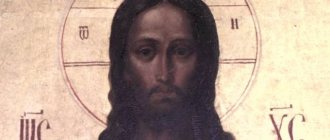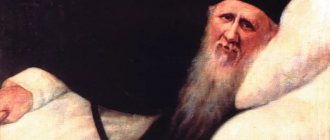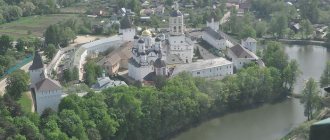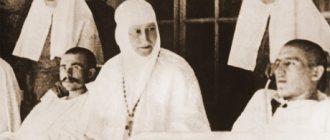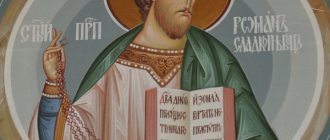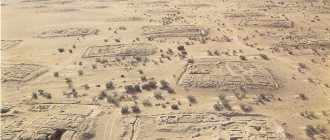MARTYRIUS
St. Martyriy Zelenetsky. Icon. XVIII century (Martiriev Zelenetsky Monastery)
St. Martyriy Zelenetsky. Icon. XVIII century (Martiriev Zelenetsky Monastery)
(In the world Mina; † 03/1/1603, Zelenetsky Monastery), Venerable, Zelenetsky (memorial March 1, November 11, on the 3rd Sunday after Pentecost - in the Cathedral of Novgorod Saints and in the Cathedral of St. Petersburg Saints) , founder of the Zelenetsky Monastery in the name of the Holy Trinity (near the city of Tikhvin). The main source of information about M. is his “spiritual memory” - autobiographical notes preserved in the only list of the 2nd half. XVII century (RNB. OSRC. O.I.424. L. 161-176 vol.). Judging by the contents, the notes were compiled in the period 1570-1595. M., turning to his spiritual father Dosifei and the brethren of the Zelenetsky monastery, talks about the founding of the monastery and the visions and miraculous signs that he had, testifying to the holiness of the chosen place. M. is perhaps the only monk who left a detailed description of his mystical experience and hermit life. The “Spiritual Memory” is not very rich in factual information, but it is distinguished by something rare for the Middle Ages. liters with sincerity in conveying emotional experiences and aesthetic perception of visions. M.'s work occupies a special place in the development of the ancient Russian genre system. literature, anticipating the autobiographical works of the Old Believer monk Epiphanius and Archpriest Avvakum. Additional biographical information about the saint is contained in the Life of Martyrius of Zelenetsky, compiled in the 2nd half. XVII century under Metropolitan Novgorod Cornelius (1674-1695; † 1698). 11 lists of this monument have been identified, including 2 older lists related to the end. XVII century (RNB. Soph. No. 1403; RGIA. F. 834. No. 3786). The second, abridged edition of the Life was compiled in 1814 and is known in 2 copies of the 1st half. XIX century (RGIA. F. 834. No. 3996; BAN. Arch. Com. No. 179).
Vision of St. Martyria of Zelenetsky. Engraving. Beginning XXI century Artist R. V. Pisarev
Vision of St. Martyria of Zelenetsky. Engraving. Beginning XXI century Artist R. V. Pisarev
The Life of the Saint tells that his parents' names were Cosmas and Stefanida. At the age of 8, he was orphaned and found a mentor - a priest. Boris, who after the death of his wife took monastic vows with the name Bogolep and became the builder of the Trinity-Sergius Monastery in Vel. Lukah. In his autobiography, M. reports that he was tonsured as a priest in this monastery. Bogolepom, stayed in the monastery for 7 years, fulfilling the duties of cellarer, treasurer and sexton, had a student Abraham. Having a persistent intention to live as a hermit, M. secretly left the monastery, taking the monastery’s lay cook as his companion. At a distance of 60 miles from Vel. They settled in a deserted place, digging a dugout. The first experience of living in the desert turned out to be difficult, and the cook soon left M., informing about his whereabouts to a certain local resident, who began to bring food to the hermit. After some time, M. sent a message to the priest. Bogolep, asking him for a blessing to live in the desert. But Bogolep did not give a blessing and ordered to return to the hostel monastery. Then M. left the hermitage and went to Smolensk to venerate the Hodegetria icon of the Mother of God. In Smolensk, the venerable Abraham of Smolensk and Ephraim appeared to him in a dream with the command to live in the desert, where God would indicate. Looking for a place to live in the desert, M. headed to the new Tikhvin Assumption Monastery (founded in 1560), intending to further go to Pomorie. At the Tikhvin monastery, M. met his disciple Abraham, who told him about the Zelenetsky Island located among the swamps. Above this place Abraham saw a cross shining in the sky. M. settled on the island, soon the brethren gathered and the Trinity Zelenetsky Monastery was formed. In the Life there are some details of M.’s arrival on Zelenetsky Island: having received the blessing of the Tikhvin abbot, he took with him 2 icons - the Holy Trinity and the Tikhvin image of the Mother of God “Hodegetria”. The peasant Joseph from the village served as his guide. Buborina, located 4 fields from Zelenetsky Island. In his “memory” M. mentions that he received the rank of abbot in Novgorod and talks about his mystical visions. After one of the visions of the sovereign, clerk F.D. Syrkov donated funds for the construction of a wooden refectory in the monastery. in honor of the Annunciation.
The founding of the Zelenetsky monastery, according to scribe books, can be attributed to the period 1565-1570. In the scribe book of the Obonezh Pyatina of 1564, compiled by Andrei Likhachev, the Zelenetsky Monastery is not mentioned, and in 1570 the monastery already existed, because this year Syrkov, who managed to make a donation, was executed. According to the “Scribe Book of the Obonezh Pyatina, the Zaonezh Half, the letter of Ondrei Vasilyevich Pleshcheev and the clerk of the Kuzmin Family, 7091,” in 1583 M. was already the abbot of the monastery, in which 12 monks labored. The wooden Trinity and refectory Annunciation churches and a fence were built in the monastery.
St. Martyriy Zelenetsky. Painting of the Trinity Cathedral of the Martiriev Zelenetsky Monastery. 1908 Photograph. 2013
St. Martyriy Zelenetsky. Painting of the Trinity Cathedral of the Martiriev Zelenetsky Monastery. 1908 Photograph. 2013
The Life tells in detail about an important event not mentioned by M. in the “memory”. In 1595, on his way to Moscow, M. stopped in Tver and healed the terminally ill Tsarevich John, the son of Kasimov Khan Simeon Bekbulatovich (from 1576 Grand Duke of Tver; in the schema of Stefan). M.'s trip to Moscow in 1595 could really have taken place, since this year the letter of grant from Tsar Theodore Ioannovich to the Zelenetsky monastery for 2 parts of land and fishing on Lake Ladoga is dated. In gratitude for the healing of his son, Simeon Bekbulatovich, at his own expense, built the first stone church in the Zelenetsky monastery - in honor of the Tikhvin Icon of the Mother of God with a chapel in the name of St. John Chrysostom. Near the wall of this temple in 1603, M. was buried in a grave that he dug with his own hands. In the 70s XVII century, under Metropolitan of Novgorod. Cornelius, tonsured at the Zelenets monastery, the stone Trinity Cathedral and Annunciation Church were built in the monastery. with a refectory, a bell tower, cell buildings, a fence; old stone Tikhvin church. dismantled. When the monastery was rebuilt, M.'s burial was located under the Trinity Cathedral, in the lower center. in the name of ap. John the Theologian. Here St. Cornelius arranged M.'s tomb, but the saint's relics remained hidden.
Cancer over the burial of St. Martyrion of Zelenetsky with the image of the resurrection of the son of Simeon Bekbulatovich. 1857 Engraving. 1883
Cancer over the burial of St. Martyrion of Zelenetsky with the image of the resurrection of the son of Simeon Bekbulatovich. 1857 Engraving. 1883
Veneration of the memory of the saint undoubtedly existed in the Zelenetsky monastery, but only requiem services were held at his tomb. The earliest iconographic image of M. is a half-length image of the 17th century, stored in the Museum of Icons in Recklinghausen (Germany). M. was revered by the Old Believers: most of the later lists of M.’s Life are in Old Believer collections. The image of M. is present in the row of saints on the Old Believer menaion icons for March.
Official church veneration of M. began in 1747. The Chronicler of the Zelenets monastery, known from a single manuscript of the 1st half, tells about this. XIX century, originating from the library of the Tikhvin Assumption Monastery (RGIA. F. 384. No. 3996. L. 34-62; the last events described here date back to 1790). Under 1747, the Chronicler contains a story about a visit to the Zelenetsky Monastery of the Emperor. Elizaveta Petrovna. Having bowed to M.’s tombstone, she asked what services M. were performing in the monastery. Hearing in response that there were funeral services, Elizabeth ordered from now on to serve M. according to the general Menea. The text of the service to the monk is in the same manuscript as the Chronicler (RGIA. F. 384. No. 3996. L. 1-16). The canon is taken from the general Menaion with the addition of special kontakion and ikos. The service is also composed according to the general Menea with the following differences: special stichera are composed for the small vespers and troparion, at the great vespers - special Glory of the 8th tone, litia and stichera for the stichera, at Matins - special luminaries, theotokos and laudatory stichera.
In con. XIX century Based on data from the Life of M., the Akathist of St. was compiled. Martyria. The text is preserved in typescript (RNB. SPbDA. A I /275), its author is unknown. The Akathist was not approved by church censorship and did not enter into church use.
In 1853, a silver shrine, decorated with scenes from the Life of the Saint, was installed over M.’s burial in the Trinity Cathedral. In 1922, the shrine was confiscated along with valuable church utensils. In 1937, the monastery was closed and reopened only in 1991. In Aug. 1992 The relics of the saint were found. 24 Nov In 1998 they were moved from the Trinity Cathedral to the Annunciation Church. and placed in a specially made ark. 24 Nov 2001 Zelenetsky monastery was visited by Metropolitan. St. Petersburg and Ladoga Vladimir (Kotlyarov). On March 14, 2003, the monastery celebrated the 400th anniversary of the repose of the saint. The canonization of the saint is confirmed by the inclusion of his name in the Councils of Novgorod (established ca. 1831, renewed in 1981) and St. Petersburg (established in 2000) saints.
Source: Martyriy Zelenetsky and the Trinity Monastery founded by him / Prepared by: E. V. Krushelnitskaya. St. Petersburg, 1998; Autobiographical story by Martyriy Zelenetsky / Prepared by. text, translation and commentary: E. V. Krushelnitskaya // BLDR. 2005. T. 13. pp. 678-691, 836-839.
Lit.: IRI. Part 4. pp. 155-182; Nevolin K. A. About Pyatina and Novgorod churchyards in the 16th century. SPb., 1853. P. 142 (Zap. RGO; 8); Buslaev F.I. East. essays russian folk literature and art. St. Petersburg, 1861. T. 2. P. 391-394; History and antiquities of the 3-class Trinity Zelenetsky monastery of the St. Petersburg diocese with appendix. records of memorable events after the death of St. Martyria happened in it. St. Petersburg, 1866; Klyuchevsky. Old Russian Lives. P. 346; Stroev. Lists of hierarchs. Stb. 273; Barsukov. Sources of hagiography. Stb. 357; Tikhomirov E. A. Perpetual calendar. M., 1882. T. 1. March. pp. 3-4; Filaret (Gumilevsky). RSv. 1882. T. 1. P. 279-283; aka. Review. 1884. P. 254; Description of the Zelenetsky Trinity Monastery. St. Petersburg, 1883; Zverinsky. T. 1. No. 194. P. 145-146; Leonid (Kavelin). Holy Rus'. No. 219. P. 52-53; Tokmakov I. F. Brief historical-stat. essay by Troitsky Zelenetsky husband. mon-rya. M., 1904; Trinity Zelenetsky Monastery and its founder, Rev. Martyrius. St. Petersburg, 1912; Zenkovsky SA Der Mönch Epifanij und die Enstehung der altrussischen Autobiographie // Die Welt der Slaven. Wiesbaden, 1956. Jg. 1. H. 3. S. 286-289; Budovnits I. U. Monasteries in Rus' and the struggle of peasants against them in the XIV-XVI centuries: (According to the “lives of the saints”). M., 1966. S. 334-336; Demkova N. S. Life of Archpriest Avvakum: Creative history of the work. L., 1974. S. 133, 161-163; Ponyrko N.V. The Life of Archpriest Avvakum as a Spiritual Testament // TODRL. 1985. T. 39. P. 385-387; Krushelnitskaya E.V. Martyriy // SKKDR. Vol. 2. Part 2. pp. 106-108; she is the same. The story of Martyriy Zelenetsky and autobiographical narration in Russian monuments. Literatures of the XIV-XVI centuries. // TODRL. 1993. T. 46. P. 21-35; she is the same. Autobiography and Life in Old Russian. lit-re. St. Petersburg, 1996; she is the same. On the issue of autobiography in Old Russian. literature // Russian. hagiography: Research, publications, polemics. St. Petersburg, 2005. pp. 102-121.
E. V. Krushelnitskaya
Iconography
Cancer over the burial of St. Martyria of Zelenetsky. 2012 Copy of the shrine 1857
Cancer over the burial of St. Martyria of Zelenetsky. 2012 Copy of the shrine 1857
The first images of M., obviously, appeared soon after his death, but neither the ancient icons of the monk nor information about them has been preserved. In the iconographic original, the saint’s appearance is described sparingly: “He was saddled with a brad like Savva of Zvenigorod, in the schema, a venerable robe” (RNB. Pogod. No. 1931. L. 54 (Oct. 25)); he is called “a wonderworker from the Tikhvin River of Tver” (see: Markelov. Saints of Other Rus'. T. 2. P. 165). The text on the scroll is according to another original: “Behold, my brethren, by the grace of God, having departed from this light, I commend you into the hand of the Lord. Have your trust in Him and in the Most Holy Theotokos in everything. Because through her prayers, she desired from the Lord and received it. Even now, although I am leaving you in body, I am still with you in spirit. Which of you, living in this monastery, will leave this world, the imam of the Lord, with prayers for the repose of his soul [text omission], has given up his holy soul in the hands of all God. In the year from the creation of the world 7111, from the Nativity of Christ 1603 in the month of March on 1 day" (BAN. Plyushk. No. 11. L. 9 (in a special section outside the main composition of the original) (see: Markelov. Saints of Ancient Rus'. T. 2. pp. 165-166).
St. Martyriy Zelenetsky. Icon. Beginning XXI century Icon painter G. V. Gashev (Martiriev Zelenets Monastery)
St. Martyriy Zelenetsky. Icon. Beginning XXI century Icon painter G. V. Gashev (Martiriev Zelenets Monastery)
The figure of the monk, according to 19th-century sources, was placed on the blade of the small opening of St. the gates of the Tikhvin Assumption Monastery, painted by the icon painter Rodion Sergiev “with his comrades” (1662). Probably, the image of M. was in the paintings of the Trinity Cathedral of the Zelenets Monastery, executed by Novgorod and Tikhvin icon painters (c. 1684). Imp. Elizaveta Petrovna, visiting the Zelenetsky Monastery in 1747, venerated the image at the tomb of the miracle worker. Perhaps this refers to the image of M. (although at the tomb of the saint there were 2 revered images, called his cell images: the icon of the Holy Trinity and the Tikhvin Icon of the Mother of God). The earliest surviving images of M. date back to the 18th century. On the icon “Vmch. Demetrius of Thessalonica, St. John Chrysostom, St. Martyrius of Zelenetsky” (TsAK MDA) the monk is depicted in full-length, blessing, with a short rounded beard; in the left hand there is a rolled up scroll, the doll lies on the shoulders. On the icon of the Novgorod priest. Georgy Alekseev’s “Image of the Novgorod Wonderworkers” (1728, Tretyakov Gallery) M., like other saints, is shown waist-deep, in a flower cup, 2nd from the right in the bottom row. His hands are turned in a prayerful gesture to the central image of Our Lady of the Sign. Half-length image of the 18th century. (?), found in 1992 in the Church of the 12 Apostles of St. John’s Women. monastery in St. Petersburg, is located at the shrine with the relics of the saint in the Zelenetsky monastery: the monk blesses with two fingers, in his left hand he holds an unfolded scroll, above its head the Holy Trinity is depicted in the form of 3 angels. A life-size image of M. is available in the engraving by G. A. Kachalov “View of the Tikhvin Monastery” (1759), the saint is shown at the bottom right, in a cartouche frame, with Trinity Zelenetskaya in the background.
Vmch. Demetrius of Thessalonica, St. John Chrysostom and St. Martyriy Zelenetsky. Icon. Beginning XVIII century (CAC MDA)
Vmch. Demetrius of Thessalonica, St. John Chrysostom and St. Martyriy Zelenetsky. Icon. Beginning XVIII century (CAC MDA)
In the local row of the iconostasis (1818) of the Trinity Cathedral of the Zelenets Monastery there was a large icon of M. of the “old time”, in the Annunciation Church there was an icon with a view of the Zelenets monastery and M. standing next to it, in the upper part - the Tikhvin image of the Mother of God, which are carried by angels. Most likely, this composition went back to Kachalov’s engraving. In the painting (1908) of the Trinity Cathedral of the Zelenets Monastery, M. is shown as an old man with a rounded gray beard, bare head, standing on a cloud and blessing, with an unrolled scroll in his left hand.
St. Martyriy Zelenetsky. Icon. Con. XIX century (collection of F. R. Komarov)
St. Martyriy Zelenetsky. Icon. Con. XIX century (collection of F. R. Komarov)
M. is present on icons with images of Novgorod or Russian miracle workers. On the icon “The Image of All Russian Wonderworkers with Sophia the Wisdom of God” by icon painter Peter Timofeev (1814, Russian Museum) and on the drawing from it (Museum of St. Petersburg Academy of Arts; see: Markelov. Saints of Other Rus'. T. 1. No. 226. L. 3. Table 58. P. 453) the monk has a short, rounded beard and his head is not covered. On the Vygov icons of the same name from the turn of the 18th and 19th centuries. and 2nd quarter XIX century (State Historical Museum, Tretyakov Gallery; Images of Russian Saints. Cat. 93. P. 390-399. Reproduction of a fragment on p. 395; Icones russes: Les saints / Fondation P. Giannadda. Martigny (Suisse); Lausanne, 2000. Cat. 52 . P. 142-143) he is shown in a doll, his beard is longer and narrower. On a drawing from an icon of the 18th (?) century. “Novgorod Wonderworkers” the monk stands in the right group of saints, in the 5th row from the bottom, 2nd from the right; only his uncovered head is visible, his short rounded beard (Uspensky V.I., Uspensky M.I. Ancient icons from the collection of A.M. Postnikov. St. Petersburg, 1899. Plate LXIX; Markelov. Saints of Ancient Rus'. T. 1. pp. 399, 619). M. is included among the saints in the lithograph “The Council of All Saints of Novgorod” (chromolithograph by E. I. Fesenko, Odessa, 1902) and in the icon “The Image of All Russian Wonderworkers” mon. Juliania (Sokolova) (20-30s of the XX century, sacristy of the Trinity-Sergius Lavra), as well as in the author’s repetitions and copies of this icon, made at the end. XX - beginning XXI century
A high-relief image of M. in the schema, with a pectoral cross, with his hands folded on his chest, was on the lid of the saint’s silver-plated copper shrine (1855-1857). On the side sides of the shrine there were reliefs with scenes of the reverend Tsarevich John, the son of Khan Simeon Bekbulatovich, and the repose of M., on the end sides there was the appearance of M. Tikhvin Icon of the Mother of God and the text of the troparion to the saint - in a cartouche supported by angels (the shrine was recreated in 2013). K con. XIX century “distributing” icons have become somewhat widespread - pilgrimage icons, executed in cursive technique and possibly going back to the image on the end of the shrine: M. in monastic clothes, in a doll, standing on the right in a 3/4 turn; on the left is a monastery with a 5-domed temple (less often with 2 or 3 temples) and a hipped bell tower. There are half-length images of the monk, with a folded or unfolded scroll; in the latter case, the inscription is usually placed on the scroll: “Behold, he went away in flight and settled in the desert...” (Ps 54:7). On the icon from the collection of F. R. Komarov, M. with his head uncovered, holds a rosary, gives a name-giving blessing (late 19th century).
Two cycles of hagiographic illustrations were created in the beginning. XXI century for the new edition of the Life of M. Engravings of the St. Petersburg artist. R.V. Pisarev have high artistic merit, but have some discrepancies with the text of the Life (for example, instead of “Hodegetria” by Tikhvinskaya, a “Hodegetria” like Smolenskaya is depicted). The second cycle consists of 26 drawings for the Life and Akathist, stylized as drawings from ancient icons.
Modern people turned to the image of M. St. Petersburg icon painter G. V. Gashev. His works are written in conventional ancient Russian. stylistics, with a focus on the art of Dionysius. On the life-size icon M. is depicted with a staff and an unfolded scroll; on the waist - a scroll is rolled up, the handle of the staff has curved ends.
Lit.: Bekeneva N. G. About the icon “Image of the Novgorod Saints” from the collection. Tretyakov Gallery // Artist. heritage: Storage, research, restoration. M., 1984. P. 95. Ill. 12; Russian mon-ri: Art and traditions. [B. m.], 1997. P. 197.
I. L. Buseva-Davydova
Holy Trinity Zelenetsky Monastery
Information on the history of the monastery is contained in the manuscript of the first half of the 19th century from the library of the Tikhvin Assumption Monastery “ Chronicle of the Zelenetsky Monastery. After the repose of the Monk Martyria, what unfortunate events befell the holy monastery, and how it was corrected purely through the prayers of the saint .” During the Time of Troubles, in 1612-1613, all the wooden buildings of the Zelenetsky monastery were burned by the Swedes. The monastery was restored thanks to the Novgorod Metropolitan Cornelius . Most of the monastery's surviving buildings were built in the 1680s.
Holy Trinity Zelenetsky Monastery
Archbishop of Novgorod and Velikolutsk Theodosius (Yanovsky) took from the Zelenetsky monastery the bishop's sacristy, about 350 of the most valuable icons in frames, silver utensils, 17 books, 3 bells. The monastery lost its assigned monasteries, villages and most of its land holdings, and in 1698 it was assigned to the Novgorod bishop's house with the obligation to pay rent. The economy fell into decay, the monastery burned in 1710, 1715, 1727 and 1730. By decree of February 20, 1762, the monastery was transferred to the state and left to its own maintenance without a government salary. By decree of the Senate on November 1, 1762, the mentally ill began to be sent to the monastery. The monastery was closed in 1919 and reopened only in 1993. The relics of St. Martyrios and St. Cornelius rest in the monastery.
Literature
- Acts of martyrs and acts of saints // Encyclopedic dictionary compiled by Russian scientists and writers. - St. Petersburg, 1861.
| This is a draft article about Christianity. You can help the project by adding to it. |
| This is a draft article about literature. You can help the project by adding to it. |
| Type of life | Life-martyrium • Life-biography |
| Collections | Cheti-Minea • Prologue • Patericon • Synaxarion • Aismavurk |
| Apocryphal genres | Legend • Walking • Vision • Word • Gospel |
| Related Articles | Menaea • Months |
Description
This type of hagiography historically developed in the Byzantine Empire and relates primarily to early Christian saints, dating back to the 1st century AD. At this time, persecution of Christians took place, when almost all those who openly professed their faith became martyrs. All works of this type are constructed according to one type of narrative; they are subject to certain literary canons, leading the hero through certain situations (semantic nodes):[1]
- A pagan undergoes the rite of baptism or declares his faith in Christ;
- After some time, representatives of the powers that be offer to renounce their faith - to make a sacrifice to the pagan gods;
- The character refuses to fulfill the proposal, and often there is a clash of faith between the pagans and the Christian, in which the Christian wins. In this case, miracles often occur;
- In response, the character is subjected to terrible physical torture, but he remains unharmed or is healed by supernatural means;
- A character who has not renounced goes to his death himself or is led to his death.
This scheme is quite natural for constructing a literary work, and early Christian authors worked freely within its framework. At the same time, Byzantine writers opposed the outstanding literature of the Hellenistic era, such authors as Plutarch and Longus. This scheme made it possible to combine the features of hagiography and fiction in the life: in the form of a Byzantine novel, the story of the fate of the hero’s personality was written, the lyrical line of the work, which included wanderings, unexpected meetings and separations, struggles with rivals, abductions, etc.; In addition, the plot is written as a predetermined novel. Hagiography is the hagiography and martyrdom of the character being described. The accounts of the lives of the saints are so florid that literary scholars compare them to a secular novel, which includes hagiographic elements—visions and dreams.[1]
